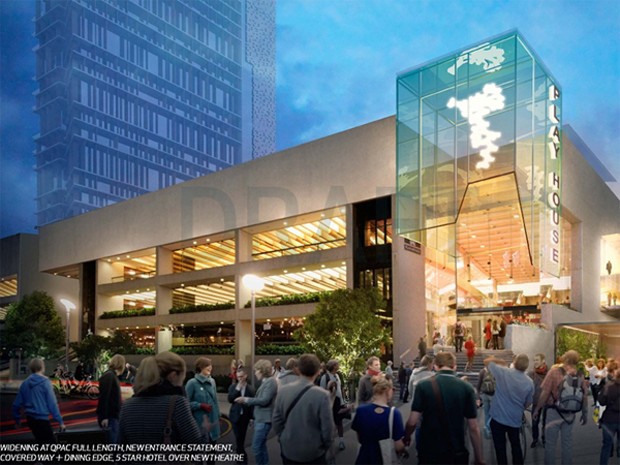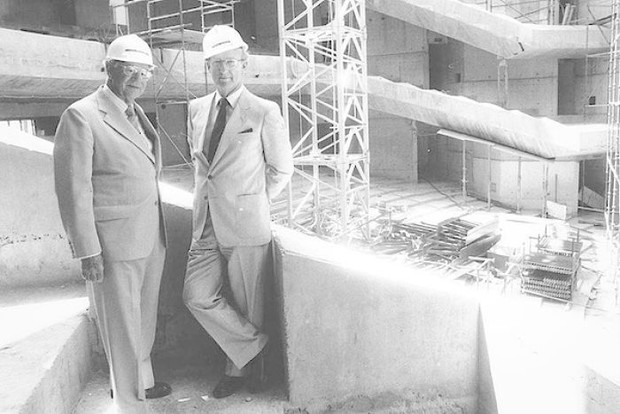The Queensland chapter of the Australian Institute of Architects (AIA) has lodged an application for the Queensland Cultural Precinct at Brisbane’s Southbank to be heritage-listed before plans by the state government to build two 30-storey towers on the site are realised.
The two skyscrapers, which are proposed to be built above the Queensland Performing Arts Centre (QPAC) and over the Queensland Museum expansion, are part of a 20-year cultural precinct masterplan developed by Cox Rayner, Urbis and Lord Cultural Resources. A draft was released in April this year.
However the Queensland Cultural Centre (QCC) is considered among Australia’s most successful examples of brutalist architecture.
Located on Brisbane's riverside, the QCC comprises the Queensland Art Gallery (QAG), [Auditorium], Queensland Performing Arts Centre (QPAC), the Queensland Museum (QM), Queensland State Library (QSL) and the Gallery of Modern Art (GOMA).
Designed and built between 1975 and the mid-1980s, the QCC is “a nationally pre-eminent example of Brutalist architecture, an aesthetic movement which was important in the second half of the twentieth century as a reaction to the abstraction associated with international modernism”, according the heritage application lodged by the Australian Institute of Architects Queensland chapter.
Designed by architect Robin Gibson (1930-2014), it’s considered the most important work of the architect, who dominated Queensland architecture in the second half of the twentieth century. The heritage application also mentions a large number of other Queensland-based consultants and stakeholders for whom this is a defining project.
Along with the Institute, the Gibson’s family have opposed the proposed changes, noting that the development opposed the vision of its late architect, Robin Gibson. Gibson’s wife Jane in particular, believes the towers would irrevocably alter the precinct, and notes the changes appear to be commercially driven.
“It seems an appropriate use of space,” said Jane in an interview with the ABC. “Part of the ideology of the building was to have a low-rise set with the mountain ranges behind – well, that will be completely obliterated.”
The Brisbane Times reported Gibson's daughter, Tina Gibson, who is now an architect herself and working in Europe, created a Facebook page titled Queensland Cultural Centre Campaign to protest the state government’s plans and oppose the high-rise plans.


Queensland Institute President Richard Kirk has also expressed his disappointment with the proposed towers, saying “they are undesirable from a conservation point of view”, “undesirable from an urban point of view”, and “clearly unworkable from a financial point of view”. Instead, he hopes the culture precinct will retain its low-rise nature.
“You typically don’t build over large span structures like a performance space or a museum, particularly with a tower. It would render those tower sites the most expensive tower sites in the city,” he noted.
The Institute’s heritage application argues for the exceptional aesthetic significance as a ‘highly unified and sculptural building complex painstakingly realised over more than a decade’.
“QCC demonstrates key aspects of Brutalism, but softened, and made publicly palatable by its visual unity which results from the dimensional regularity both in plan and section, the repetitive use of cubic forms, often stepped, and consistent and well resolved details. Sand-blasted off-white concrete was been used throughout,” it states.
Gibson’s South Bank buildings were designed to draw Brisbane’s eye towards the river. When considering the design of what ultimately became QPAC, the well-known architect had mused that the architecture would set the stage for performances with its ever-changing levels and drama of the foyer spaces.
His art gallery design, which enclosed a contemplative pool using light-coloured, low maintenance materials, paid homage to the city’s subtropical environment, and was prized the Sir Zelman Cowen Award for Architecture in 1982.

Sir David Muir (left) and Robin Gibson (right) at the construction site of QPAC's Lyric Theatre in 1983. Source: State Library of Queensland.
Although Arts Minister Ian Walker has welcomed the heritage listing application, he was not in a rush to make any promises.
“The cultural precinct needs to be able to change and expand according to what Queenslanders want and need from their precinct," he said.
"While we should acknowledge elements of historical and architectural importance, the overriding cultural value of the area and its ability to transform over the years to come must be paramount.”
The Institute’s heritage application can be viewed here, including much detail on the original architectural competition, the winning masterplan and the design history and significance of the buildings currently on the site.
Submissions are now being considered by the Department of Environment and Heritage Protection and the Queensland Heritage Council. The heritage listing decision is expected to conclude in mid-2015.

